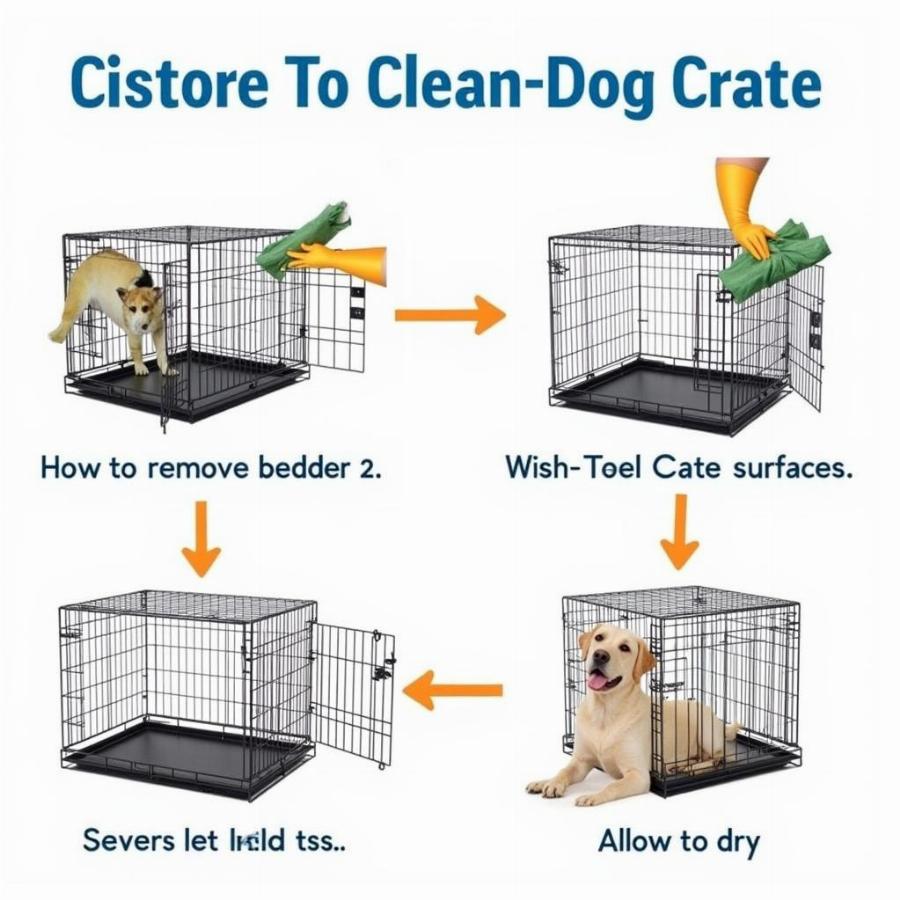Precision dog crates offer a safe, secure, and comfortable space for your furry friend. Whether you’re crate training a puppy, providing a den-like retreat for an anxious dog, or needing a reliable travel solution, choosing the right precision crate is essential. This guide will delve into everything you need to know about selecting, using, and maintaining a precision dog crate, ensuring your canine companion’s well-being and your peace of mind.
Why Choose a Precision Dog Crate?
Precision dog crates are renowned for their durability, innovative design, and focus on dog safety. Built with heavy-duty materials, these crates can withstand even the most determined escape attempts, providing a secure haven for your pet. Many precision crates also feature adjustable sizing, making them adaptable as your puppy grows. But why are these features important? Well, a secure environment can reduce anxiety and promote relaxation in dogs, creating a positive association with their crate.
Choosing the Right Size Precision Dog Crate
Choosing the correct size is crucial for your dog’s comfort. The crate should be large enough for your dog to stand up, turn around, and lie down comfortably. However, a crate that’s too large can encourage accidents, as dogs generally prefer not to soil their sleeping area. For puppies, consider a crate with a divider, allowing you to adjust the space as they grow.
What size is right for your dog? Measure your dog from nose to tail and from the top of their head to the ground (while standing). Add a few inches to each measurement to determine the appropriate crate size.
Different Types of Precision Dog Crates
Precision offers a variety of crate styles to suit different needs and preferences. From heavy-duty metal crates for strong chewers to more aesthetically pleasing wire crates, there’s a precision crate for every dog. Some popular options include the Great Crate, the Ultimate Crate, and the Petmate Vari Kennel. Each type offers unique features and benefits.
Heavy-Duty Precision Crates
These crates are designed for dogs who are escape artists or heavy chewers. They’re typically made of reinforced steel and feature stronger latches and locking mechanisms.
Wire Precision Dog Crates
Wire crates provide excellent ventilation and visibility, allowing your dog to see their surroundings. They’re also lightweight and easy to transport.
Plastic Precision Dog Crates (Travel Kennels)
These crates are ideal for travel, particularly by air. They’re durable, easy to clean, and often meet airline regulations.
How to Introduce Your Dog to Their New Precision Crate
Introducing a crate should be a positive and gradual process. Start by making the crate a comfortable and inviting space with a soft bed, toys, and treats. Encourage your dog to explore the crate on their own, rewarding them with praise and treats when they enter. Never force your dog into the crate, as this can create a negative association.
Maintaining Your Precision Dog Crate
Regular cleaning is essential to keep your dog’s crate hygienic and odor-free. Remove any bedding and wash it according to the manufacturer’s instructions. Wipe down the crate with a pet-safe disinfectant and allow it to dry completely before reintroducing bedding and your dog.
 Cleaning a Dog Crate
Cleaning a Dog Crate
Conclusion
Precision dog crates are an excellent investment for any dog owner. By understanding the different types of crates available and choosing the right size for your dog, you can create a safe, comfortable, and secure space for your furry companion. Remember to introduce your dog to the crate gradually and maintain it regularly for optimal hygiene and longevity.
FAQs
-
How do I choose the right size precision crate for my puppy?
Consider a crate with a divider that allows you to adjust the space as they grow. Measure your puppy and add a few inches for comfort. -
Are precision crates airline approved?
Some precision crates, especially the plastic travel kennels, are airline approved. Always check with the specific airline for their regulations before traveling. -
What if my dog doesn’t like their crate?
Introduce the crate slowly and positively, making it a comfortable and inviting space with treats and toys. Never force your dog into the crate. -
How often should I clean my dog’s crate?
Clean the crate regularly, removing and washing bedding weekly, and wiping down the crate itself with a pet-safe disinfectant. -
What are the benefits of using a precision dog crate?
Precision crates offer a safe, secure, and comfortable space for your dog, aiding in house training, reducing anxiety, and providing a den-like retreat. -
Can I use a precision crate for car travel?
Yes, many precision crates are suitable for car travel. Ensure the crate is secured properly in the vehicle to prevent movement during transit. -
What is the difference between a wire crate and a heavy-duty crate?
Wire crates provide better ventilation and visibility, while heavy-duty crates are designed for dogs who are escape artists or heavy chewers.
Other Questions to Explore
- What are the best dog crate accessories?
- How to prevent crate anxiety in dogs.
- How to choose the right dog bed for a crate.
You may also find these related articles helpful: dog training supplies
Beaut Dogs is your trusted source for expert advice on all things related to dog care. From breed selection to nutrition and training, we offer a wealth of information to help you provide the best possible care for your canine companion. For personalized support and answers to your specific questions, please contact us at [email protected]. Beaut Dogs is committed to empowering dog owners with the knowledge and resources they need to build strong, loving relationships with their pets. dog training For any additional questions, dog grooming tools, we’re always happy to help.